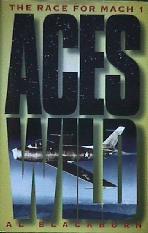![[No Amazon]](images/noamazon.jpg)

By now we all know the story of how the sound barrier was broken. It was the rocket powered X-1, flown by the legendary Chuck Yeager, that busted past the speed of sound in October of 1947. These images were recently re-enforced by the book and especially the movie "The Right Stuff". That's why I was surprised to come across a book that would question the validity of this clearly established history.
When I started to read Al Blackburn's "Aces Wild" I was very skeptical and ready to dismiss his claim that someone other than Chuck Yeager and the X-1 went through the sound barrier first. However, after reading the book I have changed my mind. Although there is no official evidence, it is entirely likely that the events he describes took place and that another pilot and a different airplane were the first ones to fly faster than sound.
First, let's consider the contending pilot. His name was George Welch. You may not know who he was, unless you studied the details of the Japanese attack on Pearl Harbor. George Welch and Ken Taylor were the two fighter pilots who got off the ground that Sunday and who shot down a dozen of the attacking airplanes. They both received the Distinguished Service Cross for that day's flight.
Later in the war, George fought in the Pacific, flying P-39 "Aircobras" and later P-38 "Lightnings". Of the two airplanes, the P-39 was a poor performer when matched against the Japanese "Zero", so the P-39 pilots were eager to transition to the P-38 as soon as possible. When George inquired as to when his squadron was to switch to the P-38s, the answer was "when you run out of P-39s". George and the other pilots came up with an unofficial way to speed up the attrition process by experiencing "engine failures" over the waters of Redscar Bay, just north of Port Moresby. The pilot only had to bail out, paddle to shore in his raft and walk back to base. Although jumping out of a "disabled" P-39 was not without risk, it was much safer than facing the Japanese "Zeros" with such an outdated airplane.
George Welch finished his career as a fighter pilot with 348 combat missions and 16 victories. In 1944, on recommendation of general Hap Arnold, George was asked to join North American Aviation as an engineering test pilot. He accepted the position, moved to L.A., and spent the rest of the war flight testing the new variations of the "Mustang".
Next let's look at the airplane. North American Aviation is the company who's design team produced the P-51 "Mustang", perhaps the best fighter airplane of World War II. Their design to follow the "Mustang" was code named XF-86 and became the famous F-86 "Sabre", the swept wing jet fighter. The XF-86 prototype was finished in late summer of 1947 and this was the airplane that George Welch began testing in the fall of that year.
It is well known that the F-86 can easily exceed the speed of sound in a dive so it is very likely that during the first flight of the XF-86 George Welch sped past the "barrier" with no difficulty. The reasons given by the author why such a flight could not be made official were mostly political. Consider that the Bell X-1 project has been sponsored by the newly formed Air Force and it would be "politically incorrect" to have the sound barrier easily broken by different airplane built with private funds.
The entire story is more believable when you consider that the author himself was a test pilot for the Navy and then for North American Aviation, and was a founding director and the third president of the Society of Experimental Test pilots.
Although the question of who flew faster than sound first is certainly important to consider, I found the sections of the book that described the author's flight test experiences far more interesting. For example, in one chapter Al Blackburn describes how production versions of the F-86F "Sabre" were tested to show that each aircraft would hold together in the "upper right corner" of the performance envelope. This test required demonstration of maximum allowed g-load at maximum indicated airspeed.
The indicated airspeed, that is the speed shown by the airspeed instrument on the panel is determined by measuring the pressure of the air that hits the airplane as it moves forward. At high altitudes, where the atmosphere is thin, it is impossible for the airplane to reach high indicated airspeed, because there is not enough air. Therefore to conduct this demonstration in the densest air, the "Sabres" were tested above the Salton Sea in the southern California. Salton Sea happens to be 235 feet below sea level. The actual test consisted of diving towards the ground to achieve the required indicated airspeed, and when this speed was reached a 7.3 g pull up was executed. Typically the pull up would occur few hundred feet above the water.
Sadly, it was in a 1954 demonstration of the "upper right hand" corner on the F-100A that George Welch was killed, when the airplane he was testing came apart. This is perhaps one of the main reasons why his claim to the breaking of the "sound barrier" has been nearly forgotten.
I enjoyed reading "Aces Wild" for two reasons. First, I found the story of George Welch and the sound barrier fascinating. However, I think that the first person descriptions of flight testing were the best part of the book.
Reviewed by: Richie Bielak, 3/99